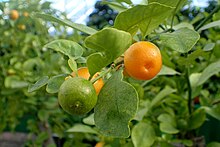| Calamansi | |
|---|---|

| |

| |
| Scientific classification | |
| Kingdom: | Plantae |
| Clade: | Tracheophytes |
| Clade: | Angiosperms |
| Clade: | Eudicots |
| Clade: | Rosids |
| Order: | Sapindales |
| Family: | Rutaceae |
| Genus: | Citrus |
| Species: | C. × microcarpa
|
| Binomial name | |
| Citrus × microcarpa Bunge
| |
| Synonyms[1] | |
| |
Calamansi (Citrus × microcarpa),[2] also known as calamondin,[3] Philippine lime,[4] or Philippine lemon,[5] is a citrus hybrid cultivated predominantly in the Philippines. It is native to the Philippines, parts of Indonesia (Borneo, Sumatra, and Sulawesi), Malaysia, and Brunei, as well as parts of southern China and Taiwan.
Calamansi is ubiquitous in traditional Philippine cuisine. It is naturally very sour, and is used in various condiments, beverages, dishes, marinades, and preserves. Calamansi is also used as an ingredient in Malaysian and Indonesian cuisines.
Calamansi is a hybrid between kumquat (formerly considered as belonging to a separate genus Fortunella) and another species of Citrus (in this case probably the mandarin orange).[6]
- ^ "Citrus × microcarpa Bunge". Plants of the World Online. Royal Botanic Gardens Kew. Retrieved 18 February 2024.
- ^ Cite error: The named reference
Mabberley 2004was invoked but never defined (see the help page). - ^ "Calamondin". Merriam-Webster. Retrieved 11 November 2018.
- ^ Tacio, Henrylito D. (11 April 2019). "Health benefits of calamansi". BusinessMirror. Retrieved 18 October 2020.
- ^ "Philippine Lemon". Stethnews.com. 4 May 2015. Archived from the original on 22 November 2020. Retrieved 8 October 2020.
- ^ "Citrofortunella Mitis – (Plants): Definition". Archived from the original on 3 July 2019. Retrieved 22 February 2009.